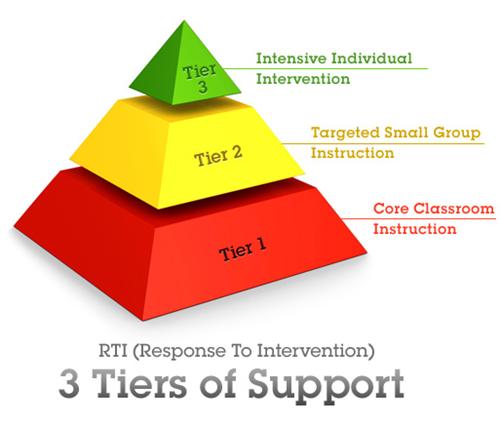Response to Intervention (RTI) & Intervention and Referral Services (I&RS)
-
The information contained on these pages will serve as a resource manual for the principal, supervisors, teachers, and parents as they work together in conjuntion with other school personnel to develop a program to meet the needs of students struggling to learn. We believe that we can work together to ensure every child is sucessful. Our structured Response to Intervention (RTI) and Intervention and Referral Services (I&RS) framework will help us with this goal. Please navigate through the many tabs to learn more about our program and resources available. For more detailed information about South Harrision's RTI and I&RS framework, you may reference the RTI / I&RS Parent Handbook.
-
What is RTI?
RTI is a data- driven, systematic approach to instruction that uses three tiers of research-based strategies and interventions to optimize student growth.
Mission Statement:
South Harrison’s Response to Intervention (RTI) program supports our district’s Commitment to Excellence. By evaluating and meeting individual students’ needs through differentiated instruction, we aim to: optimize student growth, develop the whole child, create enduring understandings and instill a love of learning.
Goals:- Support all students and staff with the RTI model.
- Gather, analyze, and utilize data to drive instruction.
- Use research-based materials and instructional practices.
- Utilize targeted strategic intervention strategies to improve student achievement.
- Partner with families to provide optimal support for students.
Essential Components of RTI-
Multilevel Prevention System
Multi-level prevention system provides access to increasingly intense levels of instruction and interventions. It includes three levels of intensity or prevention, primary, secondary, and tertiary prevention. These levels are sometimes also called Tier I, Tier II, and Tier III.
-
Universal Screening
Screening is a system for identifying students at risk for poor learning outcomes.
-
Progress Monitoring
Progress monitoring is a system for monitoring student progress and the effectiveness of the supports provided to students.
-
Data-Based Decision Making
Data-based decision making occurs at all levels of RTI implementation and all levels of instruction.
Core Instruction (Tier I)
All students receive Tier I interventions, also known as “Best Practices” during their core instructional time with their classroom teacher(s). Tier I instruction is typically successful with 80-90% of the population.
Targeted Small Group Instruction (Tier 2)
Based on academic school-wide screening, students who are not meeting grade level benchmarks and for whom Tier I interventions are not supportive enough will receive Tier 2 interventions. Tier 2 interventions may be provided by the classroom teacher or an interventionist.
Highly Specific Instructional Intervention (Tier 3)
Students that require additional or more intensive supports than Tier 2 offers will receive Tier 3 intervention. This may include more frequent, more intensive, and/or one-on-one support. Typically Tier 3 represents 1-5% of the population.


